Blockchain OTP: A Peer-to-Peer Offline Mesh Blockchain Network for Resilient Societies
Abstract
Blockchain OTP is a decentralized blockchain network designed to operate over local and global peer-to-peer mesh networks, enabling offline transactions without the need for continuous internet connectivity or centralized institutions. Traditional blockchain networks often rely heavily on internet access and resource-intensive mining processes, limiting their usability in regions with poor connectivity and contributing to environmental concerns.
Blockchain OTP addresses these limitations by integrating:
- Mesh Networking Technology: Facilitates resilient, decentralized communication over local and global networks, even in war-torn, disaster-affected areas, or during total societal collapse.
- One-Time Passwords (OTP): Enhances transaction security through time-based authentication.
- QR Code-Based Wallets: Simplifies wallet management by replacing complex seed phrases with scannable codes.
- Proof-of-Network (PoN) Consensus Mechanism: Incentivizes network participation and ensures scalability.
- Hyper Scalability Techniques: Incorporates sharding and optimized consensus algorithms to handle massive transactions per second (TPS).
- Smart Contract Capability: Enables programmable transactions for real-world applications in mining, real estate, voting, and more.
- Global Connectivity Solutions: Utilizes technologies like LoRa and advanced mesh protocols to achieve global reach without reliance on traditional internet infrastructure.
- EMP and Solar Flare Protection: Implements strategies to safeguard the network against electromagnetic disruptions using Faraday cages and resilient hardware.
- Introduction of Blockchain OTP Token: A unique cryptocurrency designed specifically for the Blockchain OTP network, enabling secure and efficient transactions.
By combining these features, Blockchain OTP aims to provide a fast, secure, and highly scalable blockchain solution, particularly beneficial in areas lacking reliable internet connectivity, or where infrastructure is compromised due to war, natural disasters, or electronic warfare.
Table of Contents
- Introduction
- The Need for Resilient Communication in Modern Society
- Mesh Networking Technology
- Blockchain OTP Token: The Unique Cryptocurrency of Blockchain OTP
- Transactions
- Timestamp Server
- Proof-of-Network (PoN)
- Network Operation
- Incentive Mechanism
- Hyper Scalability
- Confirmation and Security
- Simplified Wallet Management
- Smart Contract Capability
- Use Cases and Applications
- Calculations and Scalability Analysis
- Privacy Considerations
- Conclusion
- References
1. Introduction
The modern world faces unprecedented challenges, including continuous wars, natural disasters, and the looming threat of total societal collapse due to electronic warfare or catastrophic events like electromagnetic pulses (EMP) and solar flares. These events can cripple traditional communication infrastructures, leading to a breakdown in societal functions and a heightened distrust in traditional financial systems.
Blockchain OTP presents a robust solution by leveraging local and global mesh networks to facilitate offline peer-to-peer transactions. By integrating enhanced security measures, smart contract capabilities, and simplifying user interaction, Blockchain OTP aims to create a more accessible, efficient, and resilient blockchain network capable of handling massive transaction volumes and supporting real-world applications, even in the face of global disruptions.
2. The Need for Resilient Communication in Modern Society
2.1 Societal Collapse Scenarios
- Electronic Warfare: The use of EMP weapons can disrupt or destroy electronic devices and communication networks, leading to a breakdown in societal infrastructure.
- Natural Disasters: Solar flares and geomagnetic storms can induce currents that damage electrical grids and communication systems.
- Internet Blackouts: Cyberattacks or policy-driven internet shutdowns can isolate communities and disrupt economic activities.
2.2 Distrust in Traditional Finance
- Centralized Control: Financial institutions and governments have significant control over currency and transactions, leading to concerns over privacy and autonomy.
- Economic Instability: Inflation, bank failures, and economic policies can erode trust in traditional financial systems.
- Need for Alternatives: Communities seek decentralized solutions that are resilient to institutional failures and external disruptions.
Blockchain OTP provides a decentralized platform that remains operational even when traditional systems fail, offering a trustworthy alternative for financial transactions and information exchange.
3. Mesh Networking Technology
3.1 Concept of Mesh Networking
A mesh network is a decentralized communication system where each node connects directly to multiple other nodes, forming a network capable of rerouting data dynamically.
3.2 Advantages in Blockchain OTP
- Offline Operation: Functions without internet, critical during infrastructure collapse.
- Resilience: Maintains connectivity despite node failures or attacks.
- Scalability: Expands as more nodes join, enhancing network capacity.
- Decentralization: No reliance on central authorities or infrastructure.
3.3 Global Connectivity with LoRa and Advanced Mesh Protocols
LoRa (Long Range): A low-power, wide-area network technology enabling long-distance communication up to 15 km in rural areas.
B.A.T.M.A.N. Advanced: An enhanced mesh routing protocol suitable for large-scale networks.
Combined Approach: Integrating LoRa with mesh protocols allows Blockchain OTP to achieve global reach without traditional internet.
Benefits:
- Extended Range: Connects distant nodes, forming a global mesh network.
- Low Power Consumption: Essential for battery-operated devices in remote areas.
- Robustness: Resistant to jamming and interference common in electronic warfare.
4. Blockchain OTP Token: The Unique Cryptocurrency of Blockchain OTP
4.1 Introduction to Blockchain OTP Token
Blockchain OTP Token is the native cryptocurrency of the Blockchain OTP network, designed to facilitate secure, efficient, and decentralized transactions across the mesh network. It serves as both a medium of exchange and a unit of account within the ecosystem, enabling users to transact without reliance on traditional financial systems.
4.2 Uniqueness and Features
Uniqueness of Blockchain OTP Token:
- Offline Transaction Capability: Specifically designed to support offline transactions over mesh networks, making it resilient in environments without internet connectivity.
- Integrated OTP Security: Each transaction incorporates a One-Time Password (OTP), enhancing security against unauthorized access and fraud.
- Environmental Sustainability: Utilizing the Proof-of-Network (PoN) consensus mechanism, the Blockchain OTP Token avoids energy-intensive mining processes, reducing its environmental impact.
- Smart Contract Support: Transactions can include smart contract code, enabling programmable transactions and decentralized applications (DApps).
- EMP and Solar Flare Resilience: The design of the Blockchain OTP Token and the underlying network infrastructure includes strategies to protect against electromagnetic disruptions.
4.3 How Blockchain OTP Token Works
Creation and Distribution
Initial Supply: A fixed initial supply of Blockchain OTP Tokens is generated at the genesis block to bootstrap the network.
Node Rewards: New tokens are introduced into circulation through rewards to nodes that contribute to the network, based on their Network Contribution Score (NCS).
Transaction Mechanics
Transaction Structure: Each transaction includes inputs, outputs, an OTP, and a digital signature, as detailed in Section 5.
Transaction Fees: A standard transaction fee of 1% is applied, incentivizing network participation and sustainability.
Confirmation Process: Transactions are confirmed through the PoN consensus mechanism, ensuring security and integrity.
Use Cases
- Medium of Exchange: Enables peer-to-peer transactions for goods and services within the network.
- Smart Contracts and DApps: Users can create and interact with smart contracts using the Blockchain OTP Token, unlocking various applications in different sectors.
Comparison with Other Cryptocurrencies
| Feature | Blockchain OTP Token | Bitcoin | Ethereum |
|---|---|---|---|
| Offline Transactions | Yes | No | No |
| Consensus Mechanism | PoN | PoW | PoW/PoS |
| Smart Contract Support | Yes | Limited | Yes |
| Energy Efficiency | High | Low | Medium |
| Mesh Network Integration | Yes | No | No |
| EMP/Solar Flare Resilience | Designed for | No | No |
Mathematical Framework
Total Supply (\( S_t \)):
\[ S_t = S_0 + \sum_{i=1}^{N} R_i \]
- \( S_0 \): Initial supply.
- \( R_i \): Rewards distributed at time \( i \).
- The total supply is controlled to prevent inflation, ensuring the value of the Blockchain OTP Token remains stable.
Reward Distribution (\( R_i \)):
\[ R_i = \frac{T_f \times \text{NCS}_i}{N_t} \]
- \( T_f \): Total transaction fees collected.
- \( N_t \): Total NCS of all participating nodes.
- \( \text{NCS}_i \): Network Contribution Score of node \( i \).
Security Considerations
- Double-Spending Prevention: Ensured through the PoN consensus mechanism and OTP integration.
- Attack Resistance: High resilience against common blockchain attacks due to the decentralized mesh network and PoN.
5. Transactions
5.1 Transaction Structure
Each Blockchain OTP Token transaction includes:
- Inputs:
- Previous Transaction Hash: References the output being spent.
- Sender's Public Key: Identifies the sender.
- One-Time Password (OTP): Time-based code for enhanced security.
- Outputs:
- Recipient's Public Key: Identifies the recipient.
- Amount: The value being transferred in Blockchain OTP Tokens.
- Transaction Fee: 1% of the transaction amount.
- Optional Smart Contract Code: Embedded code for programmable transactions.
- Signature:
- Digital Signature: Created using the sender's private key to authenticate the transaction.
5.2 OTP Integration
Utilizes the Time-based One-Time Password (TOTP) algorithm:
\[ \text{OTP} = \text{Truncate}(\text{HMAC-SHA1}(K, T)) \]
- K: Secret key unique to the user.
- T: Current timestamp divided by a time step (e.g., 30 seconds).
- Truncate: Extracts a 6-digit code from the hash output.
Benefits:
- Enhanced Security: Prevents unauthorized transactions.
- Dynamic Authentication: OTP changes periodically, reducing the risk of interception.
6. Timestamp Server
Blockchain OTP uses a distributed timestamp server to ensure transactions are recorded in chronological order.
Block Structure
- Index: Block's position in the chain.
- Previous Hash: Hash of the preceding block.
- Timestamp: Time of block creation.
- Transactions: List of validated transactions, including smart contracts.
- Nonce: Number used once for proof-of-work (if applicable).
- Hash: SHA-256 hash of the block's contents.
7. Proof-of-Network (PoN)
7.1 Concept
Proof-of-Network (PoN) incentivizes nodes to contribute to the network's connectivity and reliability. Nodes demonstrate their contribution by:
- Sharing connectivity resources (e.g., acting as mesh network nodes).
- Relaying transactions and blocks.
- Maintaining network uptime and stability.
7.2 Network Contribution Score (NCS)
\[ \text{NCS}_i = \alpha \times \text{Uptime}_i + \beta \times \text{Bandwidth}_i + \gamma \times \text{Connections}_i + \delta \times \text{RelayCount}_i \]
- Uptime\(_i\): Active participation time of node \( i \).
- Bandwidth\(_i\): Data throughput provided.
- Connections\(_i\): Number of unique connections served.
- RelayCount\(_i\): Number of transactions/blocks relayed.
- \(\alpha, \beta, \gamma, \delta\): Weighting factors (determined by the network protocol to balance the importance of each metric).
7.3 Integration with Mesh Networking
- Connectivity Measurement: Nodes' contributions are quantified based on mesh network metrics.
- Dynamic Topology Adaptation: Nodes adjust to network changes, optimizing data transmission paths.
- Enhanced NCS Metrics: Incorporates mesh-specific factors like relay counts and network stability.
8. Network Operation
8.1 Mesh Networking Protocols
- LoRaWAN: For long-range, low-power communication.
- B.A.T.M.A.N. Advanced: For efficient routing in large mesh networks.
8.2 Handling Offline Nodes
- Local Ledger Maintenance: Nodes can operate independently when disconnected.
- Synchronization: Nodes update and resolve conflicts upon reconnection using consensus algorithms.
8.3 EMP and Solar Flare Protection Strategies
- Faraday Cages/Bags: Enclosures that shield electronic devices from electromagnetic fields.
- Resilient Hardware: Use of EMP-hardened devices to protect critical nodes.
- Decentralization: Eliminates single points of failure, ensuring network continuity.
9. Incentive Mechanism
9.1 Transaction Fees
A transaction fee of 1% is charged on each Blockchain OTP Token transaction:
\[ \text{Fee} = 0.01 \times \text{Transaction Amount} \]
Purpose:
- Incentivize Participation: Rewards nodes for contributing resources.
- Network Sustainability: Funds ongoing network operations and maintenance.
9.2 Reward Distribution
Total reward for node \( i \):
\[ R_i = \left( \frac{\text{NCS}_i}{\sum_{j=1}^{N} \text{NCS}_j} \right) \times T_f \]
- T\(_f\): Total transaction fees collected during the reward period.
- N: Total number of participating nodes.
Benefits:
- Fair Compensation: Nodes are rewarded proportionally to their contribution.
- Encourages Relaying: Incentivizes nodes to assist in data propagation.
10. Hyper Scalability
10.1 Sharding in Mesh Networks
Sharding divides the network into smaller, more manageable pieces (shards), each processing its own subset of transactions.
Mathematical Model:
\[ \text{TPS}_{\text{total}} = S \times \text{TPS}_{\text{shard}} \]
- S: Number of shards.
- TPS\(_{\text{shard}}\): Transactions per second handled by each shard.
Example:
- S = 1,000 shards.
- TPS\(_{\text{shard}}\) = 2,000 TPS.
\[ \text{TPS}_{\text{total}} = 1,000 \times 2,000 = 2,000,000 \text{ TPS} \]
10.2 Optimized Consensus Mechanisms
- Delegated Proof-of-Network (DPoN): Reduces overhead by delegating consensus to nodes with higher NCS.
- Practical Byzantine Fault Tolerance (PBFT): Provides rapid consensus with fault tolerance.
10.3 Data Propagation Efficiency
- Gossip Protocols: Efficiently spread information throughout the network.
- Adaptive Routing: Nodes select optimal paths based on real-time conditions.
- Data Compression: Use of techniques like Merkle Trees to minimize data transmission.
10.4 Mathematical Analysis of TPS
Assumptions
- Bandwidth per Node (\( B \)): Average bandwidth available to each node.
- Transaction Size (\( T_s \)): Average size of a transaction in bits.
- Propagation Delay (\( D_p \)): Time it takes for a transaction to propagate through the network.
Calculations
Maximum Transactions per Node (\( \text{TPS}_{\text{node}} \)):
\[ \text{TPS}_{\text{node}} = \frac{B}{T_s} \]
Total TPS without Sharding:
\[ \text{TPS}_{\text{total}} = N \times \text{TPS}_{\text{node}} \]
- N: Number of nodes.
Total TPS with Sharding:
\[ \text{TPS}_{\text{total}} = S \times \text{TPS}_{\text{shard}} \]
- Assuming each shard handles \( \text{TPS}_{\text{shard}} = 2,000 \) TPS.
Verification Time per Transaction (\( T_v \))
Assuming signature verification takes \( t_v = 1 \) ms:
\[ T_v = t_v \times \text{TPS}_{\text{node}} = 1 \text{ ms} \times 250 = 250 \text{ ms} \]
Nodes can handle the computational load.
11. Confirmation and Security
11.1 Three Confirmations
A transaction is considered final after inclusion in a block followed by two more blocks.
Confirmation Time:
\[ T_c = z \times t_b \]
- T\(_c\): Confirmation time.
- z = 3: Number of confirmations.
- t\(_b\): Average block time (e.g., 1 second).
Example: \( T_c = 3 \times 1 = 3 \) seconds.
11.2 Security Enhancements
- Redundancy: Multiple data paths reduce the risk of interception or tampering.
- Decentralization: Eliminates single points of failure.
- Sybil Attack Resistance: PoN requires resource contributions, making it costly to create fake identities.
11.3 Mathematical Security Analysis
Probability of Successful Attack (\( P \)):
\[ P = \left( \frac{q}{1 - q} \right)^z \]
- q: Attacker's fraction of network resources.
- z: Number of confirmations.
Example with \( q = 0.1 \) and \( z = 3 \):
\[ P = \left( \frac{0.1}{0.9} \right)^3 \approx 0.00137 \]
Interpretation:
- Low \( P \) indicates a high level of security against double-spending attacks.
- Increasing \( z \) (number of confirmations) exponentially decreases \( P \).
12. Simplified Wallet Management
12.1 QR Code-Based Wallets
- Public Key QR Code: Shared to receive payments.
- Private Key QR Code: Kept secure to authorize transactions.
Benefits:
- User-Friendly: Simplifies wallet setup and usage.
- Physical Storage: Users can print and securely store their keys.
12.2 Key Generation and Digital Signatures
Elliptic Curve Cryptography (ECC) over the secp256k1 curve.
- Private Key (\( d \)): Random integer in \( [1, n - 1] \).
- Public Key (\( Q \)): \[ Q = d \times G \] - \( G \): Generator point on the curve.
Digital Signature Algorithm (ECDSA)
Signature Generation:
- Choose a random integer \( k \) from \( [1, n - 1] \).
- Compute \( r = (k \times G)_x \mod n \).
- Compute \( s = k^{-1}(H(m) + d \times r) \mod n \).
- The signature is \( (r, s) \).
Signature Verification:
- Verify that \( r \) and \( s \) are in \( [1, n - 1] \).
- Compute \( w = s^{-1} \mod n \).
- Compute \( u_1 = H(m) \times w \mod n \) and \( u_2 = r \times w \mod n \).
- Compute \( X = u_1 \times G + u_2 \times Q \).
- The signature is valid if \( X_x \equiv r \mod n \).
13. Smart Contract Capability
13.1 Architecture
- Virtual Machine (VM): A lightweight execution environment embedded within the nodes.
- Smart Contract Language: A simplified, secure scripting language tailored for Blockchain OTP.
- Execution Model: Smart contracts are executed by nodes during transaction processing.
13.2 Use Cases
- Automated Transactions: Conditional payments based on predefined conditions.
- Decentralized Applications (DApps): Applications running on the blockchain without centralized servers.
- Interoperability: Ability to interact with other blockchains or systems through cross-chain communication.
14. Use Cases and Applications
14.1 Resilience in Total Societal Collapse
14.1.1 Communication Continuity
- Challenge: Total internet blackout due to EMP or warfare.
- Solution: Mesh networks with LoRa enable long-distance communication.
- Faraday Protection: Devices stored in Faraday bags remain operational post-EMP.
14.1.2 Economic Stability
- Decentralized Currency: Blockchain OTP Token acts as a stable medium of exchange.
- Trustless Transactions: No reliance on failing financial institutions.
14.2 Disaster and War-Torn Areas
- Aid Distribution: Smart contracts automate resource allocation.
- Community Coordination: Facilitates communication and decision-making.
14.3 Real Estate Transactions
Provides secure property transfers when legal systems are disrupted.
14.4 Mining Industry Applications
Ensures transparent and secure operations, even in remote or unstable regions.
14.5 Voting Systems
Allows secure, anonymous voting without internet, crucial during societal upheaval.
14.6 Mathematical and Scientific Analysis
Network Connectivity Probability (\( P_c \)):
\[
P_c = 1 - e^{-\lambda k}
\]
- \( \lambda \): Node density.
- \( k \): Average number of connections per node.
EMP Impact Probability (\( P_{EMP} \)):
\[
P_{EMP} = 1 - e^{-\sigma D}
\]
- \( \sigma \): EMP intensity.
- \( D \): Distance from EMP source.
Faraday Cage Effectiveness: \[ E_{shield} = 20 \log_{10} \left( \frac{E_{unshielded}}{E_{shielded}} \right) \] - \( E_{shield} \): Shielding effectiveness in dB.
15. Calculations and Scalability Analysis
15.1 Detailed TPS Calculations
Assumptions:
- Number of Nodes (\( N \)): 10,000
- Bandwidth per Node (\( B \)): 1 Mbps (megabits per second)
- Transaction Size (\( T_s \)): 500 bytes (4,000 bits)
- Sharding Factor (\( S \)): 1,000 shards
Calculations:
Maximum TPS per Node
\[ \text{TPS}_{\text{node}} = \frac{B}{T_s} = \frac{1,000,000 \text{ bits/sec}}{4,000 \text{ bits}} = 250 \text{ TPS} \]
Total TPS without Sharding
\[ \text{TPS}_{\text{total}} = N \times \text{TPS}_{\text{node}} = 10,000 \times 250 = 2,500,000 \text{ TPS} \]
Total TPS with Sharding
\[ \text{TPS}_{\text{total}} = S \times \text{TPS}_{\text{shard}} \]
Assuming each shard handles \( \text{TPS}_{\text{shard}} = 2,000 \) TPS:
\[ \text{TPS}_{\text{total}} = 1,000 \times 2,000 = 2,000,000 \text{ TPS} \]
Verification Time per Transaction (\( T_v \))
Assuming signature verification takes \( t_v = 1 \) ms:
\[ T_v = t_v \times \text{TPS}_{\text{node}} = 1 \text{ ms} \times 250 = 250 \text{ ms} \]
Nodes can handle the computational load.
15.2 Latency Reduction
\[ D_p = \frac{D}{v} \]
- D: Distance between nodes.
- v: Signal propagation speed (approximately \( 2 \times 10^8 \) m/s in wireless medium).
Average Network Diameter (\( \overline{D} \)):
In mesh networks, \( \overline{D} \) is small due to multiple paths.
15.3 Data Availability and Synchronization
- Data Availability Proofs: Ensure that data is accessible and correctly propagated.
- Cross-Shard Communication Overhead (\( O_c \)):
\[
O_c = \frac{M}{S}
\]
- \( M \): Total cross-shard messages.
- **Optimization**: Minimize \( O_c \) by efficient cross-shard protocols.
15.4 Additional Mathematical Models
- Network Throughput (\( T \)): \[ T = N \times B \times \eta \] - \( \eta \): Network efficiency factor (due to protocol overhead).
- Node Participation Probability (\( P_n \)): \[ P_n = \frac{\text{NCS}_i}{\sum_{j=1}^{N} \text{NCS}_j} \]
- Expected Reward for a Node (\( E[R_i] \)): \[ E[R_i] = P_n \times T_f \]
16. Privacy Considerations
While transactions are public, user identities remain anonymous due to the use of cryptographic keys.
Privacy Features:
- Anonymity: Users can generate new key pairs for each transaction.
- Transaction Mixing: Techniques like CoinJoin obscure transaction trails.
- Ring Signatures: Conceal the sender's identity among a group of users.
Mathematical Representation:
- Anonymity Set Size (\( A \)): Larger \( A \) increases privacy.
- Entropy Measure (\( H \)): \[ H = -\sum_{i=1}^{A} p_i \log_2 p_i \] - \( p_i \): Probability of each possible sender.
17. Conclusion
Blockchain OTP is designed to be the backbone of resilient societies, providing:
- Uninterrupted Communication: Through global mesh networks with technologies like LoRa.
- Economic Stability: A trustworthy medium of exchange independent of traditional financial systems.
- Resilience to Disruptions: Protection against EMPs and solar flares with Faraday shielding and robust network design.
- Global Reach: Not limited to local networks, enabling worldwide connectivity without internet.
- Versatile Applications: Supports smart contracts for various critical functions during crises.
- Introduction of Blockchain OTP Token: Offers a unique cryptocurrency tailored to meet the challenges of modern society.
By addressing the vulnerabilities of current systems and providing practical solutions for extreme scenarios, Blockchain OTP positions itself as the best and only solution for maintaining societal functions during total collapse.
18. References
- Satoshi Nakamoto. "Bitcoin: A Peer-to-Peer Electronic Cash System." 2008.
- RFC 6238. "TOTP: Time-Based One-Time Password Algorithm." 2011.
- ANSI X9.62. "Public Key Cryptography for the Financial Services Industry: The Elliptic Curve Digital Signature Algorithm (ECDSA)." 1999.
- B.A.T.M.A.N. Development Team. "B.A.T.M.A.N.: Better Approach To Mobile Adhoc Networking." Open-Mesh.
- T. Clausen et al. "The Optimized Link State Routing Protocol (OLSR)." RFC 3626, 2003.
- M. Castillo et al. "LoRa Modulation Techniques and Performance." IEEE Communications. 2017.
- M. Castro and B. Liskov. "Practical Byzantine Fault Tolerance." OSDI. 1999.
- E. Kokoris-Kogias et al. "OmniLedger: A Secure, Scale-Out, Decentralized Ledger via Sharding." 2018.
- J.R. Douceur. "The Sybil Attack." IPTPS. 2002.
- R.C. Merkle. "Protocols for Public Key Cryptosystems." IEEE Symposium on Security and Privacy. 1980.
- A. Back. "Hashcash - A Denial of Service Counter-Measure." 2002.
- G. Wood. "Ethereum: A Secure Decentralised Generalised Transaction Ledger." Ethereum Project Yellow Paper. 2014.
- S. Haber and W.S. Stornetta. "How to Time-Stamp a Digital Document." Journal of Cryptology. 1991.
- U.S. Department of Defense. "Electromagnetic Pulse (EMP) Protection Guidelines." MIL-STD-188-125. 1998.
- NASA. "Understanding Solar Flares and Their Effects." 2020.
- D. Boneh and M. Franklin. "Identity-Based Encryption from the Weil Pairing." SIAM Journal on Computing. 2003.
- D. Chaum. "Blind Signatures for Untraceable Payments." Advances in Cryptology. 1983.
V1.0 BLOCKCHAIN TESTING
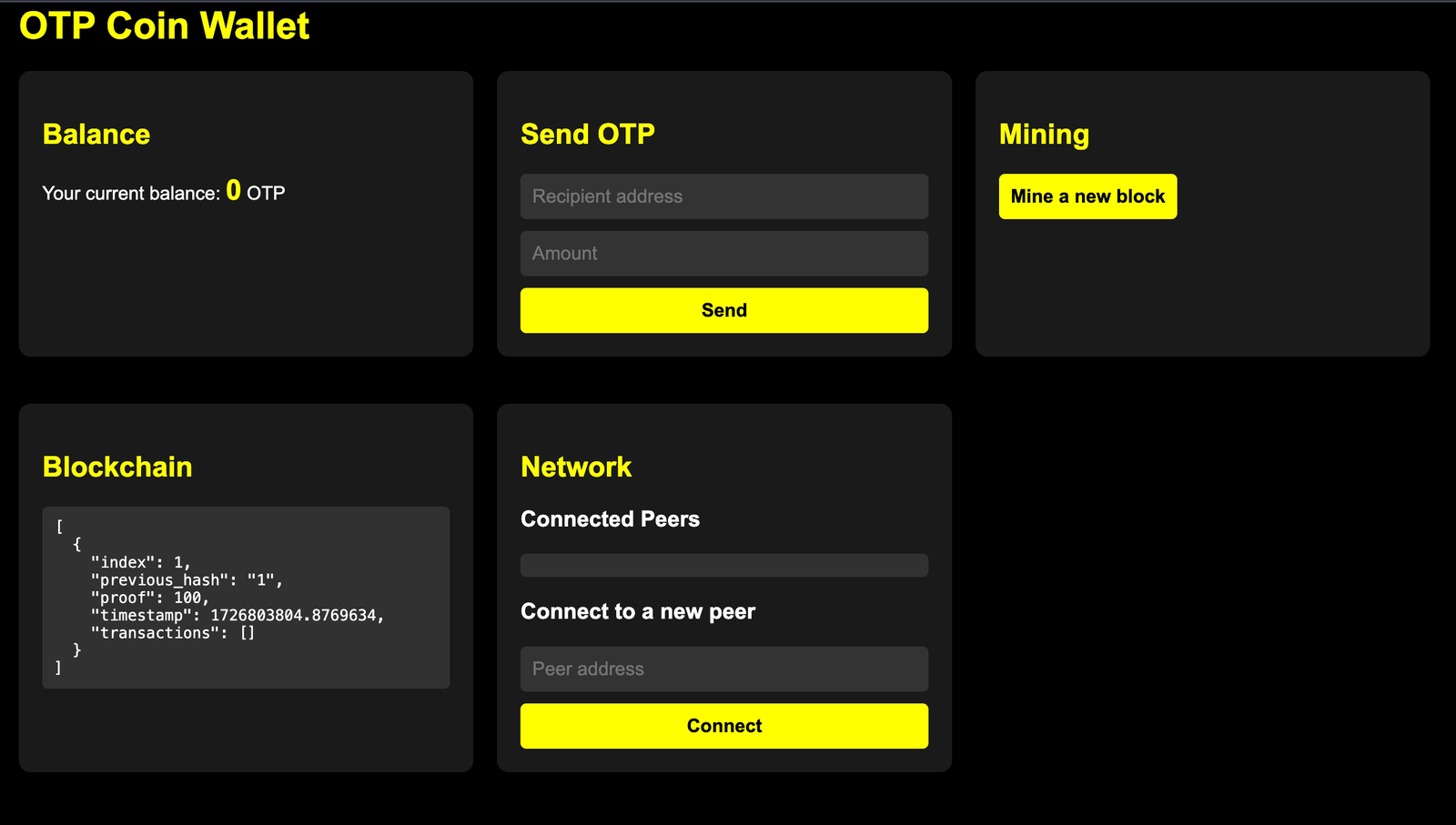




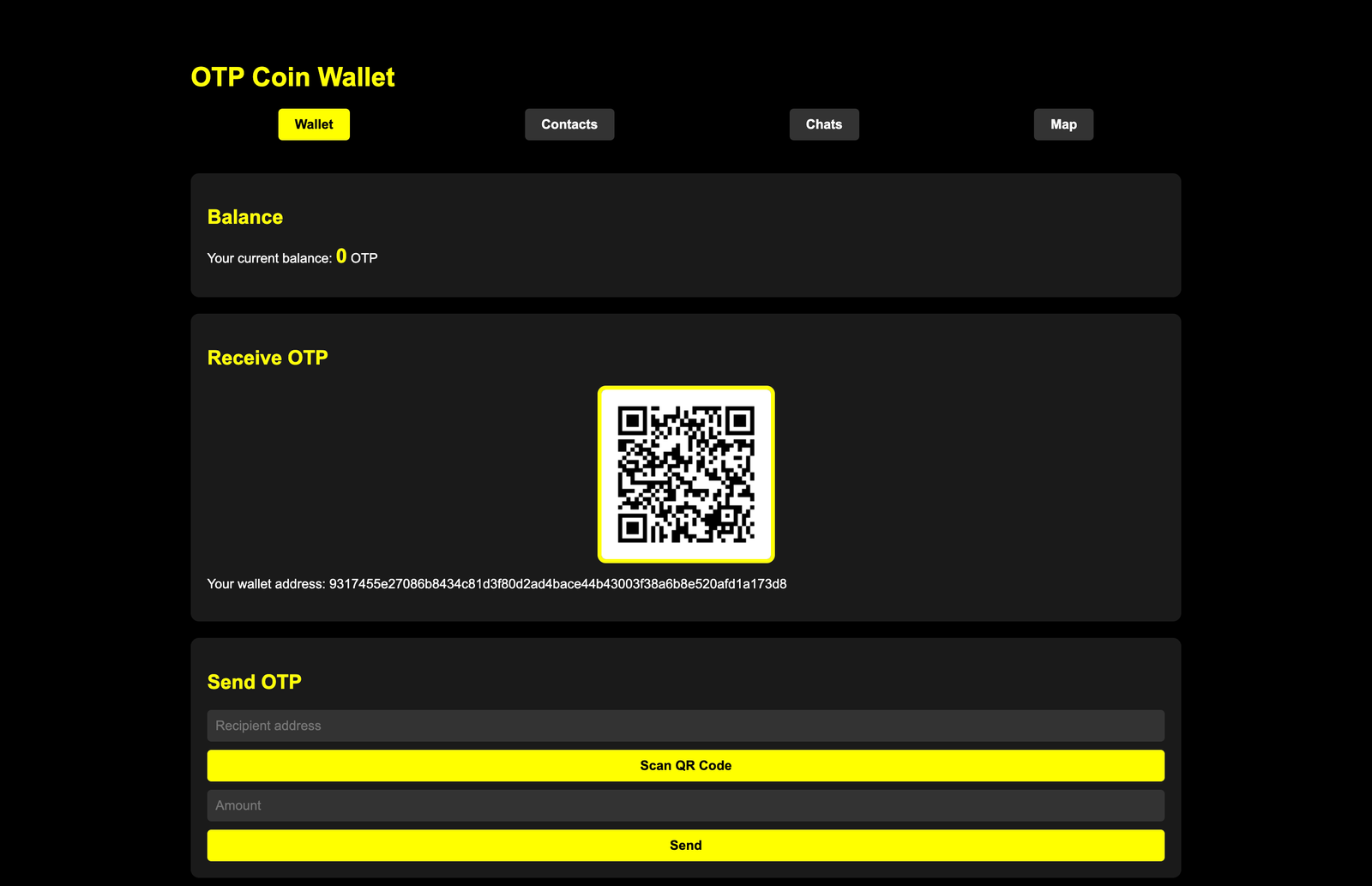
V1.0 INTEROPERABLE DAAP TESTING






V1.0 KYC / KYB ONBOARDING

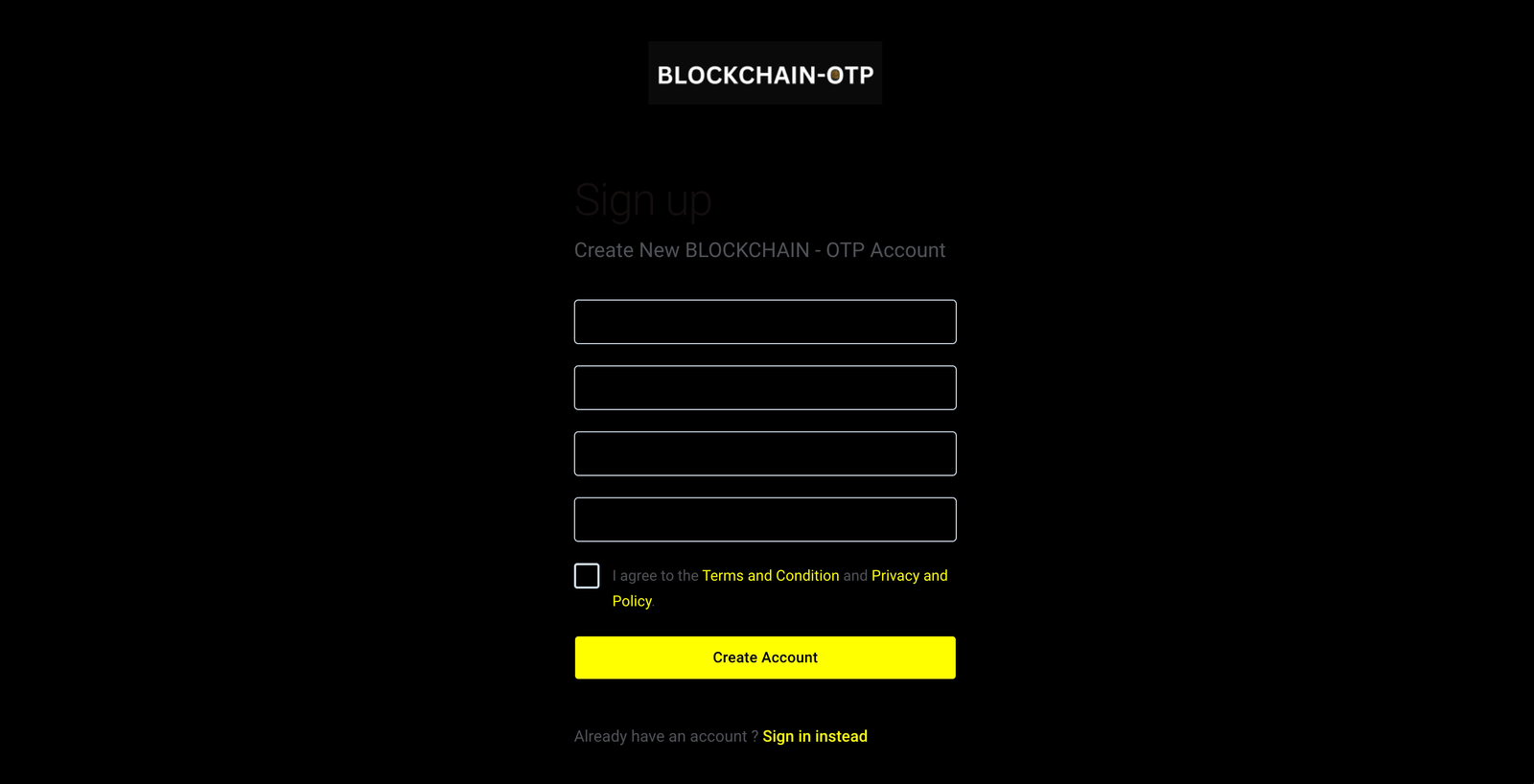
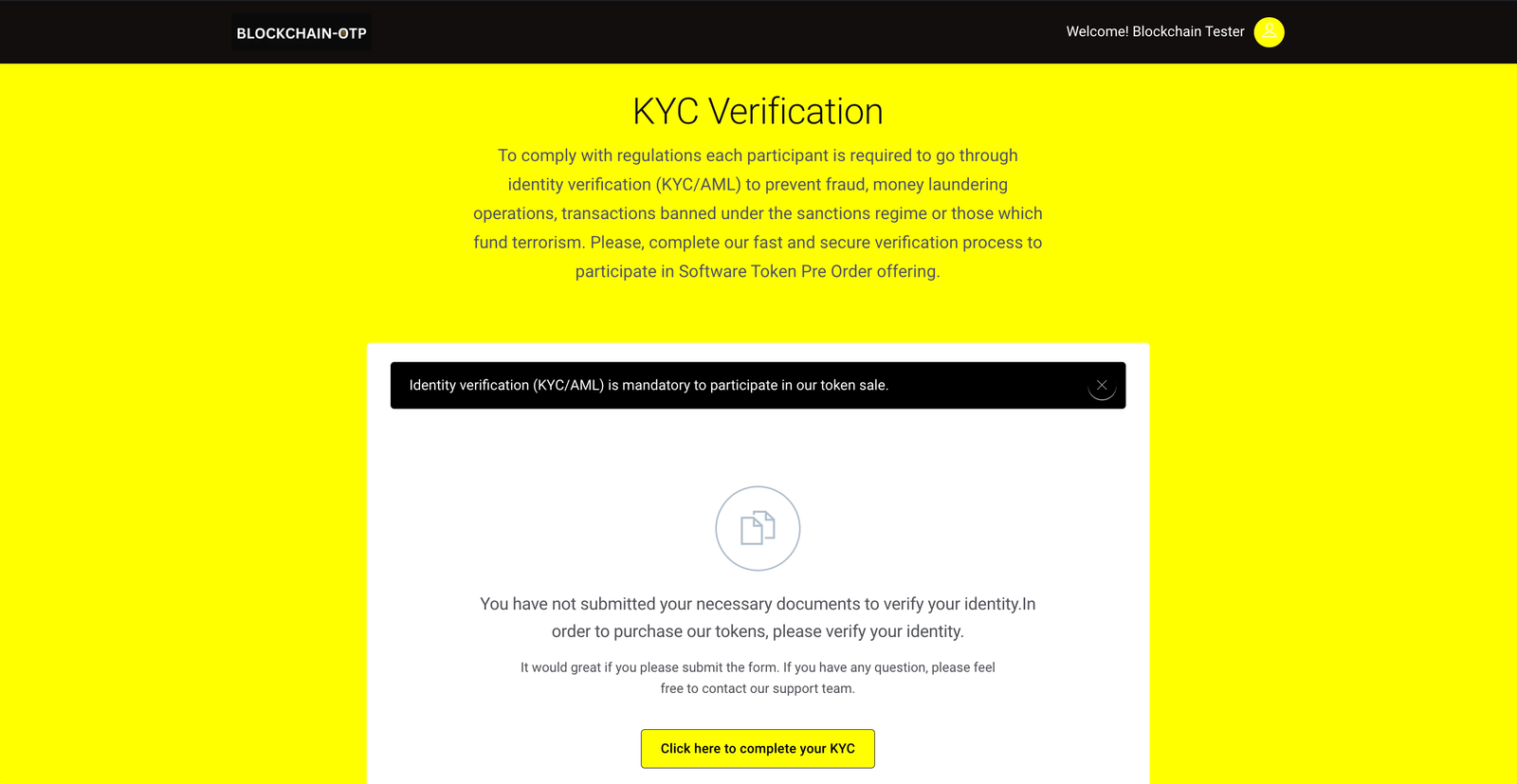
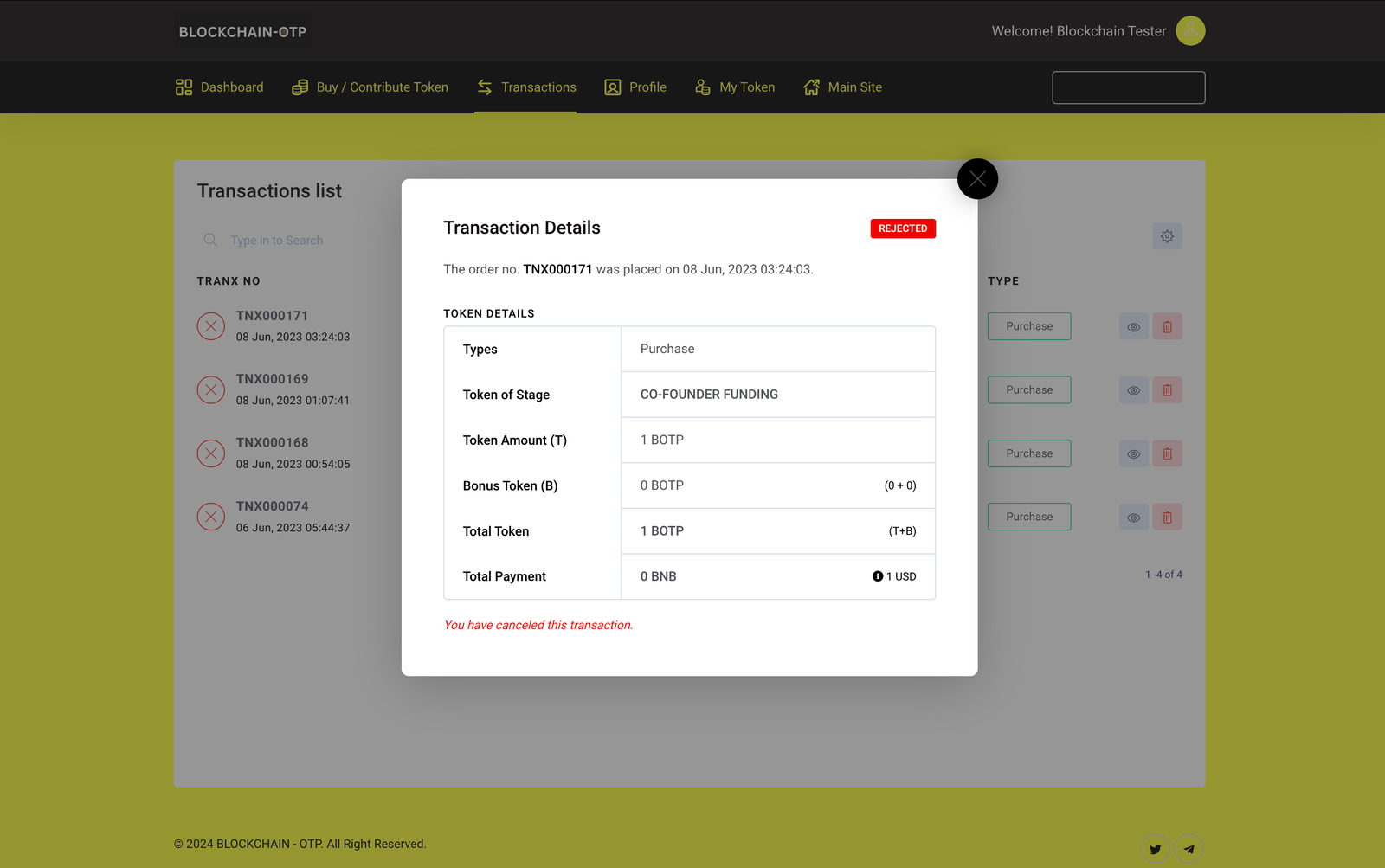
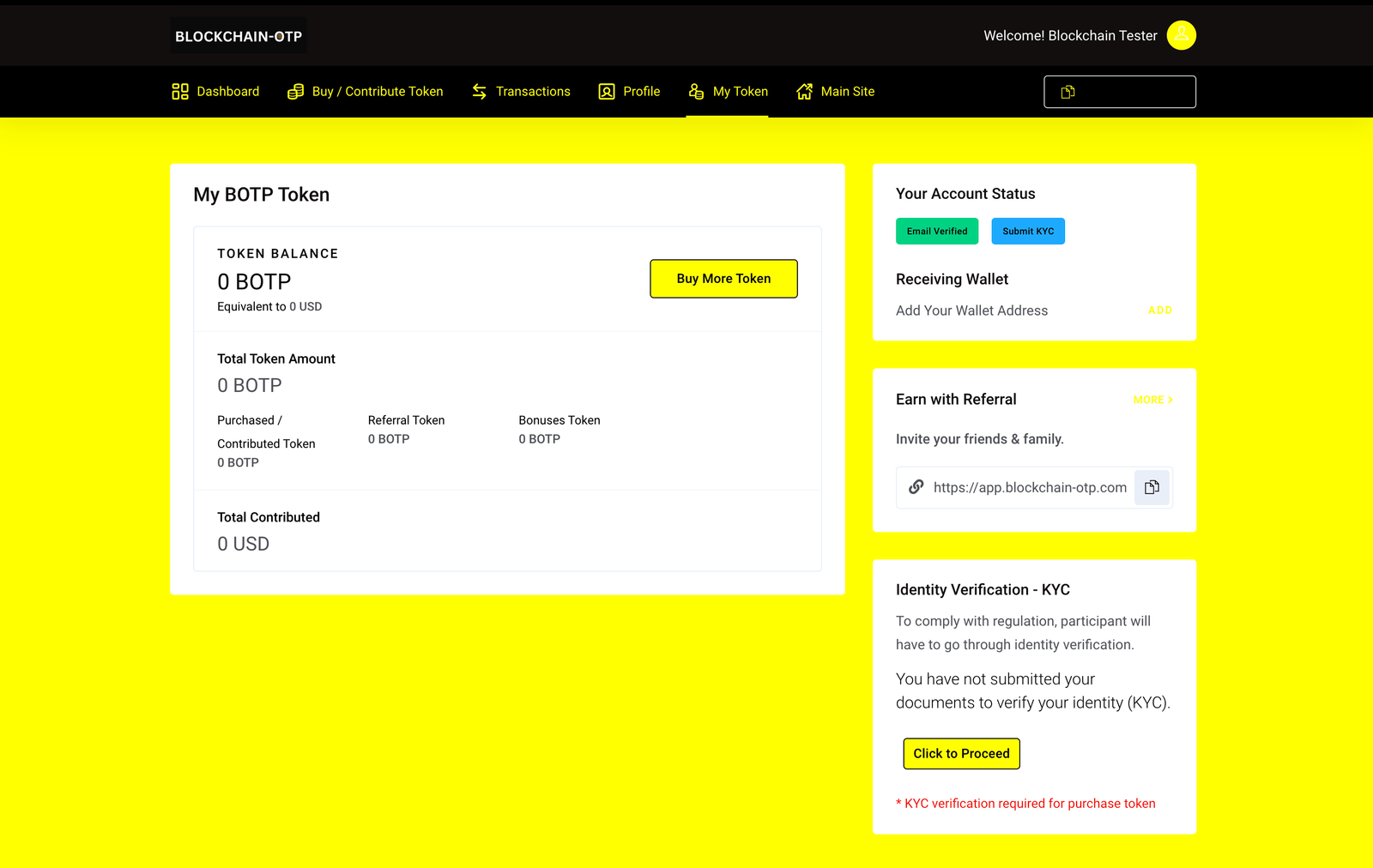








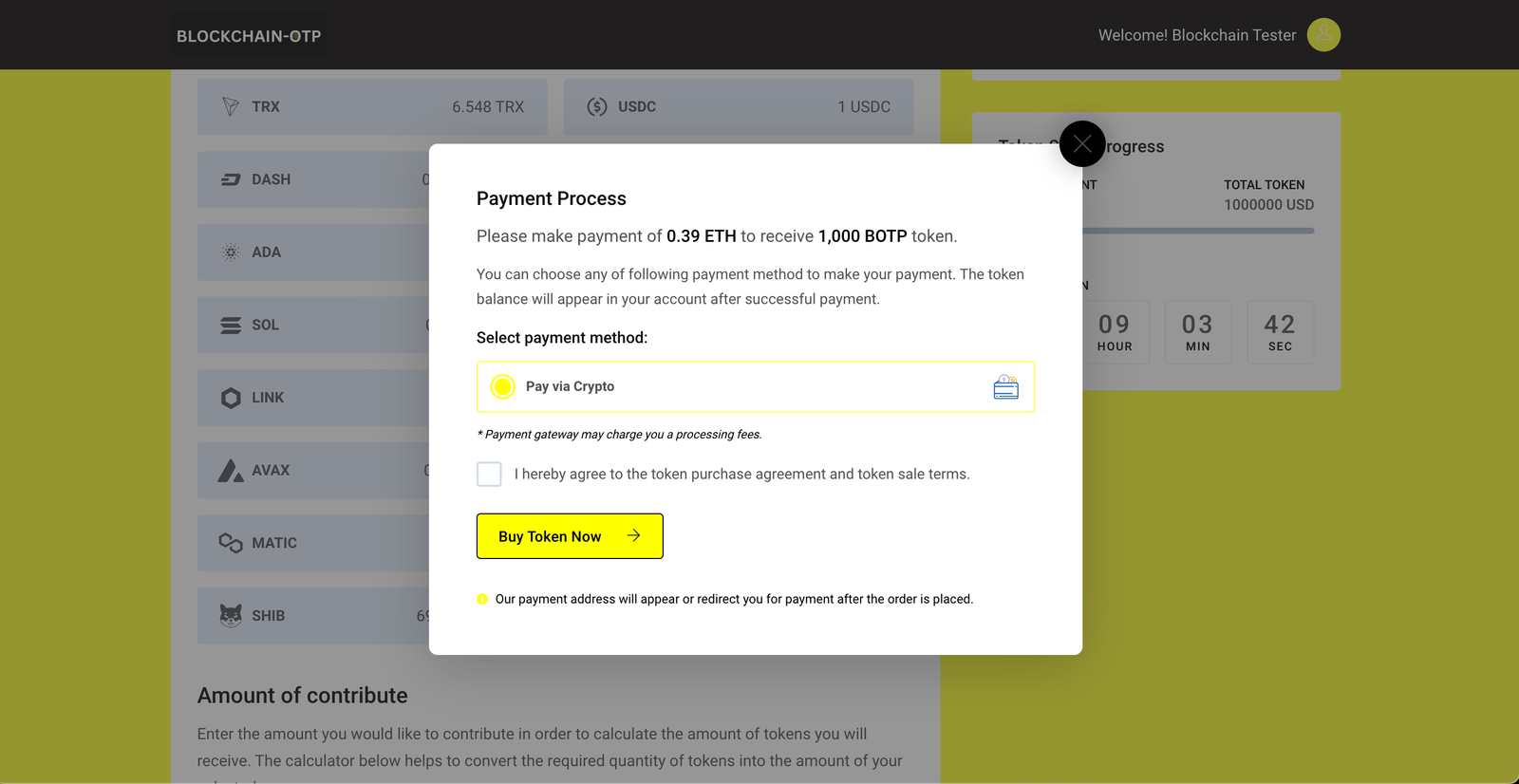
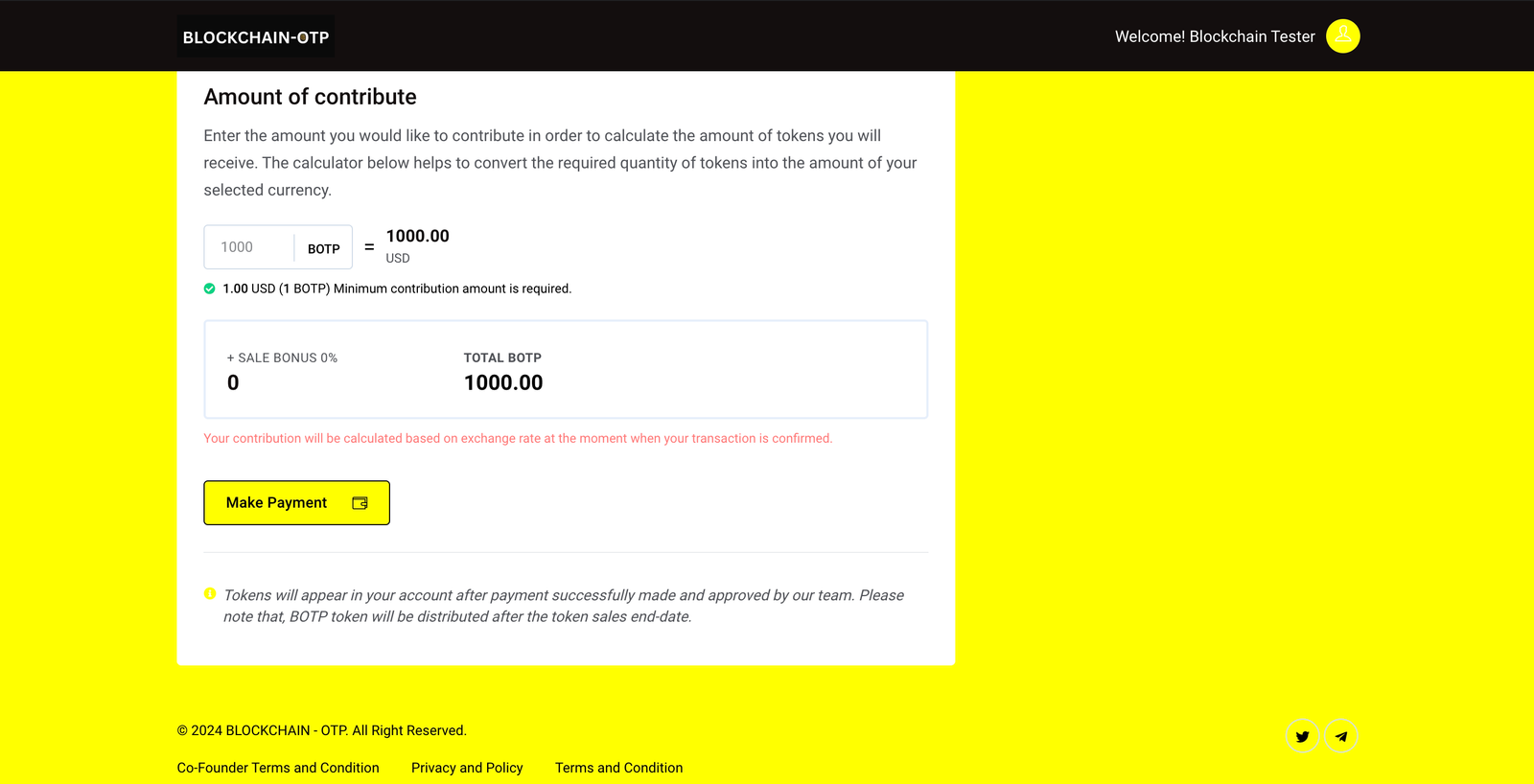
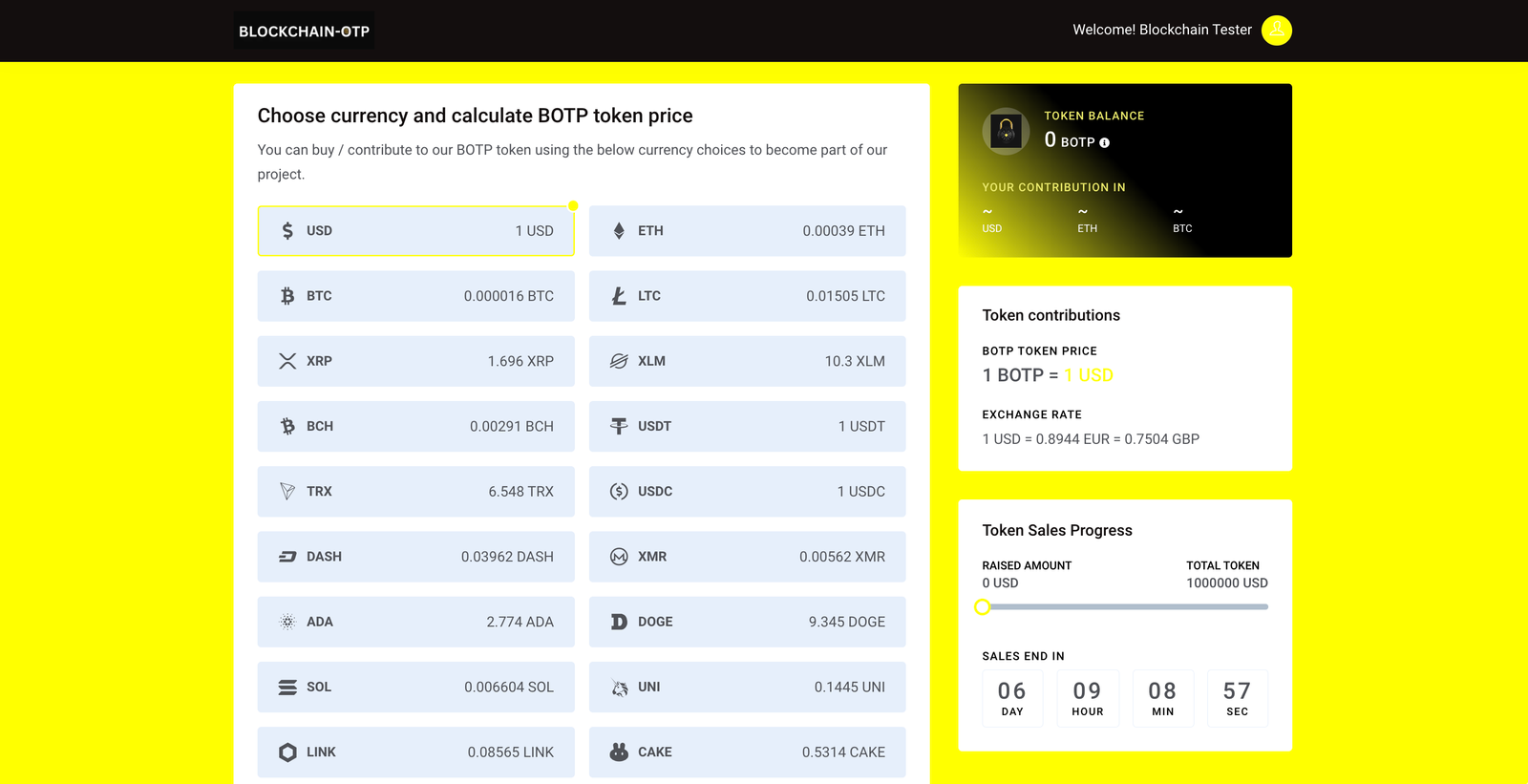
Disclaimer: This white paper presents a conceptual framework for Blockchain OTP and its native cryptocurrency Blockchain OTP Token. Further research and development are necessary to address implementation details, security considerations, and scalability challenges. Collaboration with the community is encouraged to refine and realize the potential of this proposed system.